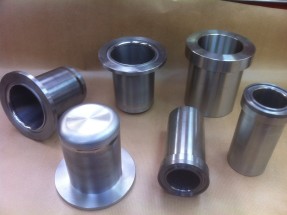
The Uses for Tantalum
Tantalum is a unique element on the periodic table, discovered in 1802 and used for a wide variety of purposes today. Making up 1-2 parts per million of the Earth’s crust, the majority of the world’s tantalum is mined in Australia, while some small supplies come from China, Mozambique, Ethiopia and the Democratic Republic of the Congo, among others.
Mined as an ore named “Tantalite”, tantalum is famous for its resistance to corrosion by acids and sea water and has a melting point of around 2990°C, which makes it perfect for use in a variety of high-heat applications. Easily fabricated and very hard, tantalum lends itself extremely well to being made into:
Heat Exchanger Tubes
Tantalum has an incredibly high thermal and electrical conductivity, which, coupled with its extremely high melting point, makes it the perfect choice for heat exchanger tubes. Since tantalum can reach temperatures of almost 3000°C without melting, it can hold enormous amounts of thermal energy and facilitate effective heat transfer far beyond the capabilities of conventional steel or copper heat exchange tubes.
Electrodes
In addition to a very high thermal conductivity and melting point, tantalum also offers a high electrical conductivity which makes it the natural choice for electrodes. Comparatively easy to fabricate and very hard, but still ductile, tantalum can be fashioned into wires and electrodes with relative ease and creates a very cost-effective electrode with a high degree of efficiency and a long lifespan.
High-heat Piping
Tantalum lends itself well to work in high-temperature situations, and one of the most vital is in piping very hot fluids in industrial applications. Tantalum piping is able to successfully pipe some molten metals, due to a melting point of almost 3000°C – for example, most steel melts at 1370°C, meaning that a tantalum pipe wouldn’t even be halfway to its melting point while piping liquid steel in an industrial situation. This, coupled with its remarkable hardness, leads to tantalum being used in the handling and processing of other molten metals, forming pipes, valves, pipe fittings and extruders as necessary.
Jet Engine Parts
Another critically important function for tantalum in the modern world is in jet engine parts. The material demands placed on jet engine components are extremely high – not only are they used in a high-stress situation as a matter of course, but their limits for safety are intense, due to the potential consequences for a jet engine component failing.
Tantalum is an excellent material for use in jet engines, and commonly occurs in alloys used there thanks for its hardness, its remarkable corrosion resistance, and its extremely high melting point. Alloys containing tantalum are able to keep their structural integrity at higher temperatures than other alloys, and thanks to the corrosion resistance of their tantalum parts, their lifespans are usually longer, making them more cost-effective.
A jet engine is never an inexpensive investment, but using the right materials in its components can really reduce the operational and maintenance costs of the machine.
Tantalum alloys are found throughout business, engineering and industry due to the many exceptional attributes of tantalum as a material. If you are interested in knowing more or think tantalum might be right for a project you are working on, you can contact China Special Metal Parts, Inc. on +86-755-29936699 or visit our https://chinesemetalparts.com/website!

Leave a response
Your email address will not be published. Please enter your name, email and a comment.